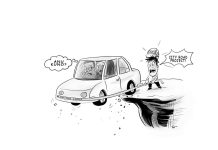
AT THE HEART of this failure lies a contractor’s calculus: lower bids win, corners get cut, and inferior materials pass as compliant. Our public procurement laws demand “Economy, Efficiency, and Effectiveness” (RA 9184), but in practice, “Economy” often eclipses all else. When steel posts are half the required thickness, or gravel footings lack the proper reinforcement, the only beneficiaries are profit-padding go-betweens and ghost projects lining a few pockets.
Meanwhile, traffic enforcers and police are supposed to direct vehicles away from pedestrian corridors. Instead, too many officers are “detail-oriented” about collecting fees from motorists rather than monitoring speed and compliance. The driver in the NAIA crash claimed panic at an imaginary sedan, but CCTV footage showed a clear straight-line acceleration toward the crowd. How many sanctions did he dodge before that fateful moment? The LTO has suspended his license for 90 days, but the lesson arrives far too late.
This is not unique to Manila. In Iloilo City, a friend once braked hard at an unlit overpass where reflective markers had peeled off months earlier. Government crews reinstalled the markers only after a minor scrape and a motorist’s complaint.
Across the country, tens of thousands of flyovers, pedestrian islands, speed humps, traffic signs, rumble strips, shoulder lanes, service pavements, highway culverts, median diverters, crash barriers, roundabouts, and drainage covers linger unfinished or built with sub-par materials. The World Bank estimates nearly 40 percent of our road network requires urgent rehabilitation (World Bank 2022). Yet budgets keep swelling, and poor workmanship keeps prevailing.
Our collective approach to accidents is reactive. We lament — then we dole out cash assistance, build temporary memorials, do lip services, hold whitewashed investigations, and rename streets. We bristle at critics but ignore how the same “quick fixes” recur: patched potholes, half-painted zebra crossings, and unanchored bollards. We treat human lives as mere line items to be compensated after the fact rather than protected from the outset.
I know this personally. One rainy night, riding a tricycle in Barotac Nuevo, Iloilo we nearly collided with a buckled traffic sign that had collapsed into the roadway. The orange reflector was long gone, and no official came to secure it for days. In that flash, I realized how easily a “small thing” can cause a major accident — how the state’s lack of vigilance can turn routine commutes into lottery draws for survival.
Changing this requires more than promises. It demands stewardship: engineers, lawmakers, and frontline officers taking ownership of every bolt, every budget, and every behavioral norm. It means auditing every public works project with forensic detail, from airport terminals to barangay pathways. It means elevating competence over connections, and discipline over dole-out culture.
Ordinary Filipinos do not need grand speeches or empty condolences. We need crash-rated fixtures installed to correct depth, regular audits that do not skip weekends, drivers held consistently accountable, and procurement processes so transparent that any cut corner is detected in daylight. We need a mindset shift from patch-and-pray to protect-and-prevent.
Let this tragedy at NAIA be the turning point. Corruption kills quietly but relentlessly in melted steel and missed inspections. When government officials walk away unscathed, and families pay with their tears and loss, we have failed at the very task of governance: to safeguard life and limb.
***
Doc H fondly describes himself as a lifelong learner who, like many others, dreams of a more life-giving and purpose-driven world built on justice, reflection, and joy. His views do not necessarily reflect those of the institutions he serves./PN







